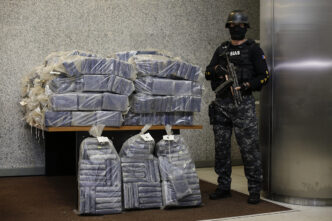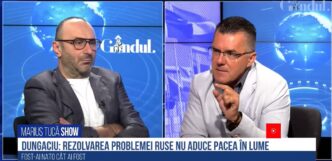The AUR and S.O.S. Romania parties did not win the June 9 europarliamentary and local elections, but neither did they lose them: 14.9% for AUR and 5% for S.O.S., the combined percentages placing the extremist pole in second place after the PSD-PNL governmental alliance and ahead of ADU (USR-PMP-Forța Dreptei) in the Europarliamentary elections.
AUR and S.O.S. are on a similar political trajectory to the PP-DD, Dan Diaconescu’s party, which peaked in 2011-2012 in the parliamentary elections, where it obtained almost 15%.
AUR and S.O.S. gained electoral momentum in 2020 and 2021 respectively (after the Simion-Sošooaca split and the emergence of S.O.S), in the context of the COVID-19 pandemic and restrictions, then the Russian invasion of Ukraine, and then inflation.
What do the results of the June 9th vote tell us about the potential of extremist political offers, but also about the attractiveness of the messages these parties are promoting to increase their electoral percentages? An Info Sud-Est analysis puts the pieces of the puzzle together.
Case study. AUR and S.O.S., voting by neighborhoods in the municipalities of Dobrogea, the region-locomotive for extremist parties
Dobrogea is the region with surprise percentages for both extremist parties in the European parliamentary elections, the highest for S.O.S. and among the highest for AUR.
Info Sud-Est has analyzed the voting by districts in the two municipalities of Constanta and Tulcea, where the parties got the most votes in the two counties (according to the number of votes).
The analysis shows that AUR and S.O.S. obtained the most votes, in general, in neighborhoods of social assistance recipients, low-income or working-class neighborhoods.
Thus, in Constanța, AUR obtained the highest percentages, between 22 and almost 25% in the neighborhoods CET, KM 4-5 (housing area), Dorally, Palas, Galeriile Soveja and the socially assisted neighborhood Henri Coandă.

In the same areas, S.O.S. also obtained high percentages, between 9 and almost 14%, but in addition to the neighborhoods already mentioned, Palazu Mare and the Gării area.
In Tulcea, the highest percentages for AUR (between 23-27%) and the highest percentages of S.O.S. (10-17%) were obtained in Neptun, Dallas, West and two other poor, working class or socially assisted areas.

It is worth mentioning that in some of these precincts AUR and S.O.S. together exceeded 40% of the electorate’s votes.
Why in these neighborhoods?
In Constanța, one explanation for the high result of S.O.S. Romania in the municipality would be the influential factor represented by His Eminence Teodosie, the Orthodox Archbishop of Tomis, whose image Diana Șoșoacă has been glued to since 2020, when she was his lawyer during the COVID-19 pandemic.
Teodosie has repeatedly violated public safety restrictions, and Șoșoaca joined him in taking action against the authorities’ decisions, representing him in court cases.
Then, in 2022, Șoșoaca came to Constanța to protest against the demolition of a church illegally built by Archbishop Teodosie and that should be removed from the public space. Șoșoacă thus stuck to a significant part of the radical electorate, which is deeply attached to the ultraconservative values spread by Teodosie. The bishop even declared that Vladimir Putin is “a great creator” and “not so black”, immediately after the massacres in Bucha and Irpin shocked the international community.

She was also personally present during the campaign in the Henri Coandă social welfare neighborhood where she talked to residents about their grievances, went live on social media and slandered local authorities. In contrast, the S.O.S. mayoral and county council candidates are anonymous, the entire campaign being associated with Diana Șoșoaca, her presence like a dismount in the city, the county or on social media.
AUR leader George Simion also attached himself to Teodosie, and he has been present in the front line at several of the archbishop’s events.

Instead, Simion also benefited from the increased notoriety of the candidates for mayor and County Council. Ovidiu Cupșa, who was the AUR candidate for mayor, has held several public positions (local councillor, county councillor, worked in the town hall headed by Radu Mazăre, etc.) and for over a decade has run CERONAV, a key institution for sailors (under the Ministry of Transport), which organizes mandatory training and refresher courses for them and issues the related documents without which they cannot sell.
At the same time, Cupșa campaigned continuously and was massively present in the neighborhoods where AUR subsequently registered the highest percentages. Mohammad Murad, the AUR candidate for Constanta County Council is also known locally as one of the biggest investors in tourism.

In Tulcea, on the other hand, the AUR and S.O.S. candidates for mayor and the county council are not known locally, but the fact that they won the highest percentages in the mentioned neighborhoods is explained differently.
AUR members have been campaigning consistently in these neighborhoods since 2020 with the COVID-19 restrictions. Demonstrations, protests against the authorities, even neighborhood parties, the AUR electorate formed there naturally over time. The S.O.S. later broke away from this electorate, and in the elections the votes were split.
Where exactly in the country and Diaspora did AUR and S.O.S. score highest
First of all, it is worth noting that AUR, like S.O.S., obtained higher percentages in the European Parliament elections compared to the results in the local elections.
Second, the percentages show that the vote for AUR and S.O.S. was not polarized in clearly defined regions, such as Moldova, the South of the country or Transylvania, but important percentages for the final score of the parties were obtained all over the country, which rather indicates a uniform vote.
Another conclusion from the vote is that the extremist AUR and S.O.S. side won the elections in the Diaspora: together they obtained 28% compared to the 21.3% of PSD-PNL and 16.3% of ADU (USR-PMP-Forța Dreptei). For example, without the Diaspora vote (13.5%), S.O.S. would not have made it into the European Parliament.
In the Europarliamentary elections, AUR obtained the highest scores in the counties Gorj (21.5%), Arad (20.3%), Tulcea (19.5%), Hunedoara (19.2%), Suceava (19%), Alba and Vâlcea (18.5%) and Constanța (17.4%).
On the other hand, the highest results in the European parliamentary elections were recorded in Tulcea (7.6%), Constanța (7.1%), Brăila (7%), Neamț (6.8%), Bacău (6.3%), Ialomița and Prahova (6.1%) and Caraș-Severin, Iași and Târgu Jiu (5.6%).
In the Diaspora, the S.O.S. obtained the highest percentages in Germany (23.7%) and Italy (22.2%), and for AUR it was Canada (29.5%), the USA (26.7%), Australia (25.8%), Spain (20.9%) and France (16.6%) etc.
But which posts helped them make it to the European Parliament and which were the most viral sponsored posts on Facebook?
An Info Sud-Est analysis of the posts paid by AUR between April and June 9, in the pre-campaign and election campaign periods, shows that the most impactful sponsored posts on the party’s page are those related to AUR’s “program”, the ideas of the candidates for the European Parliament elections or anti-PSD&PNL messages.
A top 5 in descending order looks like this:
A series promoting AUR candidates for which the party paid between 25,000-30,000 lei between May 14-24. The series of advertisements compared Cristian Terheș and Georgiana Teodorescu with Rareș Bogdan and Virgil Popescu of the PNL. The photos were only used in the advertisement and are not posted on Facebook, but they have together garnered over 2 million views.

Another advertising campaign was active from June 3 to June 8, 2024, worth 25,000 to 30,000 lei, with an image urging people to vote AUR on election day. This series of ads was divided into 6 parts, where two of them gathered around 1 million views, while the other four ads had between 700,000 and 250,000 views per post.
A speech by George Simion in which he explains why people should vote for AUR and not for “comasații” was sponsored with between 15,000 – 20,000 lei in May. The video has 3 million views and almost 10,000 likes.
On the other hand, a song about the AUR party sung by Mugur Mihăescu, a member of the extremist party, was sponsored with between 10,000 – 15,000 lei in May. The song gathered 1.6 million views and 13,000 likes on Facebook.

Last but not least, a video featuring George Simion as the leader of AUR and promoting the platform of “jobs” that the party “offers to the people” by saying that the party “is looking for specialists” for the “AUR Government” was sponsored with 9,000 – 10,000 lei at the end of April – beginning of May. The commercial has 600,000 views and around 4,000 likes.
As for AUR leader George Simion’s Facebook page, according to the Facebook Ad Library, between May 22 and June 8, 2024 he ran a Facebook advertising campaign worth around 35,000 lei (divided into 6 ads with the same image) – the post collected over 61,000 likes and almost 23,000 comments. One of the ads garnered over a million views, while the remaining 5 have around half a million each. The post is a poll in which Simion asks the audience whether they will vote for the “commasați” or AUR.

Two other live broadcasts made by Simion were sponsored with amounts between 20,000 – 25,000 lei (live about going to the polls on June 9) and 10,000 – 15,000 lei. The first live where he talks about the Coldea case has over 1 million views and around 26,000 likes. The second live, in which Simion called for Dâncu’s removal from the list for the Europarliamentary elections, has gathered almost 2 million views.
Another live made by Simion went viral on voting day, gaining almost 2.3 million views, where he talks about vote fraud on the very day of the local elections. He is not wearing any electoral inscriptions, but he is wearing a t-shirt in AUR colors with the figure of Nicolae Bălcescu, “the leader of the 1848 generation”. This live broadcast made on June 9 was sponsored with between 10,000 and 15,000 lei.
The live broadcast made by Simion at the General Prosecutor’s Office two days before the elections, in which he accuses the party of being wronged with three “invented” criminal cases, was sponsored with about 9,000 lei. The live has 1.8 million views and almost 30,000 likes.
The analysis of the posts of Cristian Terheș, the opening act of the AUR list for the Europarliamentary elections, shows that the advertisement in which the most money has been invested is a post from the beginning of May, in which about 3,000 lei worth of investment urge people to “join the AUR army”, through an active link that redirects you on Messenger to enter into a conversation with George Simion. The ad has garnered around 300,000 views.

Another post sponsored with about 600 lei is one in which Terheș denigrates the LGBT community and highlights the “normality” he will try to maintain in the country. The post has 2,600 likes and approx 35,000 views.
An ad that paid another 600 lei talks about the fact that a German politician who is critical of illegal migration from Europe was stabbed by a Muslim man, and if we continue to vote for PSD-PNL, who “accept illegal migration” and don’t vote for a “patriot who defends Romania”, we are likely to have similar cases in Romania. The post has 4,300 likes and around 40,000 views.
Last but not least, Claudiu Târziu’s page shows that the AUR co-founder’s best paid advertisement is a photo of his promises as an MEP, a post in which between 1,500 and 2,000 lei were invested. The post has 7,600 likes and around 100,000 views.

A video from mid-April in which Claudiu Târziu explains how PSD and PNL are “the corrupt states that are dragging the country down” was sponsored with about 500 lei. The video has 1,400 likes and 58,000 plays.
Another video in which the AUR MEP explains how “Romanians work a lot and earn little” and with the help of AUR this can be stopped was also sponsored with 500 lei. The video has almost 100,000 views and 1,600 likes on Facebook.
The other ads made in the election campaign do not exceed 300 lei.
As for S.O.S. Romania or the pages of Diana Șoșoaca or Luis Lazarus, according to Facebook statistics they do not appear to have paid for ads in the last 90 days.
Following the June 9 elections, AUR will send Cristian Terheș, Claudiu Târziu, Gheorghe Piperea, Adrian Axinia, Georgiana Teodorescu and Sturdza Șerban Dimitrie to the European Parliament.
S.O.S. will be represented by the head of the extremist party, Diana Șoșoaca, and Luis Lazarus, omnipresent in the senator’s appearances and travels.
CONTEXT. Where will AUR and S.O.S. Romania end up
Once they win seats in the European Parliament, political parties have to affiliate themselves to parliamentary groups, the ones with whose doctrine they most identify. Depending on discussions with those groups, parties may or may not be accepted.

AUR chose the ultra-conservative European Conservatives and Reformists (ECR) group but where, in order to be admitted, it had to sign a declaration that it respects the territorial integrity of Ukraine and its internationally recognized borders. This happened in the context in which George Simion and Claudiu Târziu (current MEP) instigated territorial revisionism against Ukraine during the election campaign.
It should be noted that George Simion did not post either on his Facebook page or on his official website the text of this declaration requested by the ECR Group “as a basic condition” for the accession of the AUR to this group in the European Parliament.
Revisionism has been one of the central themes of the AUR and George Simion’s public discourse. The very name of the party – Alliance for the Union of Romanians – refers to the union with the territories that once belonged to Romania: the Republic of Moldova, Northern Bukovina (now part of Ukraine) and Southern Bessarabia (Bugeac).
AUR joined the ECR as the founder and president of the Polish sovereignist party, Jarosław Kaczyński, is seeking an exit from the ECR because Polish sovereignists are now more oriented towards the much more radical Marine Le Pen, who is campaigning in the Identity and Democracy (ID or “Sovereignists”) group, the far-right of the EU’s most radical MEP group.
However, on Friday, G4Media wrote in exclusivity about how elected S.O.S. MEPs Diana Șoșoacă and Luis Lazarus were not even welcomed in this most radical EU group.
The pair opted for the “Sovereignists” group, but were opposed by German neo-Nazi AfD MEPs, who said they voted unanimously not to welcome the S.O.S. into their ranks.
If they are not welcomed into any group in the EP, and the chances are slim, the two S.O.S. MEPs, Șoșoacă and Lazarus, will operate as non-attached MEPs and will have no negotiating power in the Brussels legislature.
In 2023, the 7 groups in the EP were the following:
-The European People’s Party (Christian Democrats) – EPP,
-Progressive Alliance of Socialists and Democrats in the European Parliament – S&D, Renew Europe Group,
-European Free Alliance,
-Identity and Democracy – ID/Sovereignists,
-European Conservatives and Reformists – ECR,
-Left
And then there are the non-affiliated, which includes independents or those who are not accepted or do not identify with any of the existing groups.
Contributions were made by Cristian Andrei Leonte and Gabriel Mateescu
- The article is part of a journalistic series realized within the Expanding Production of Independent Content (EPIC) project, coordinated by the Independent Journalism Center (IJC) with the financial support of Internews.
Ne bucurăm că ne citești!
Dacă vrei să ne și susții:











